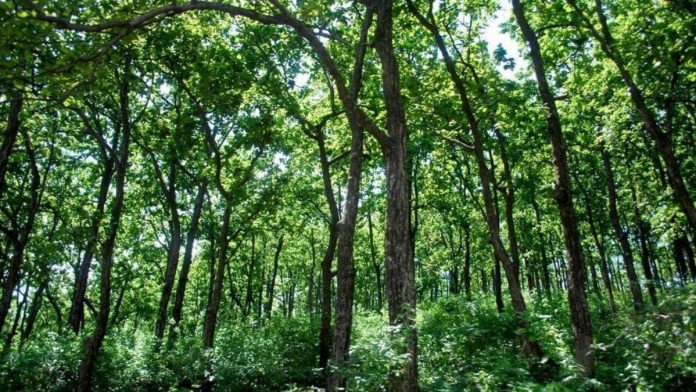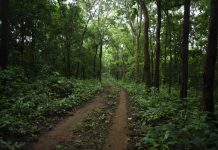This article has been written by Bheeni Goyal, from Symbiosis Law School, Pune which was written on whether the Forest Right Act has been effective in the implementation of the Right of Livelihood and the protection of the forests.
Table of Contents
Introduction
Forest Rights Act of 2006 was enacted for the purpose of recognising the forest rights and vesting those rights in the dwelling Scheduled Tribes and other forest dwellers who have been staying in the forest for generations. This Act provides the proper procedure for recognising the rights of the forest dwellers and investing the rights in them in respect of the reserved forest land. Providing individual rights and recognising the communities is the sole objective of the Act.
This Act has recognized various rights of the dwellers which include the right to use the resources of the forest, right to use the land of the forests for the purpose of cultivation, the right to conserve the forests, etc, but the government has shown enough insensitivity towards protecting the rights of the forest dwellers over the protection of wildlife, forests and for various commercial interests.
Since the enactment of the Act, many hectares of forests have been diverted towards industrial purposes. Therefore, the Act is under controversy for a long time. Let’s see the various provisions of the act for the protection and development of the rights of the dwellers and their contribution to the conservation of the forests under this Act.
A weapon of democracy in the forest-provisions of the Forest Rights Act
Historical Development of the Act
Scheduled Tribe Communities have been staying in the forest for many generations. They started residing in the forest and their livelihood depends on farming and cultivating various things like bamboo or tendu leaves. For many years their rights of livelihood were not disturbed per se, as long as there is no degradation of the forests.
But during the time of the colonial government, the focus shifted from the protection of the rights of local communities to the commercial interest for the purpose of doing more and more agriculture on the land on which the communities have been residing. Even after independence, the government for many years was not able to protect the rights of forest dwellers and their rights were always compromised. Like the Wildlife Protection Act,1972 wanted to protect the wildlife and forest from any degradation but still, the rights of the dwellers were ignored. Therefore to protect the rights of the dwellers, The Scheduled Tribes and Other Traditional Forest Dwellers (Recognition of Forest Rights) Act 2006.
Necessity for the law
There were various governmental policies both in the colonial as well as independent India, in which the rights of the forest-dwelling communities over their resources were taken away. Therefore, this Act was developed to correct the wrong of all those governmental policies.
There were various states in which the Naxal movement was initiated like in the state of Chattisgarh, Jharkhand, etc., because of the alienation of certain scheduled tribes. This Act provided the inclusion of those tribes by identifying Community Forest Rights and Individual Forest Rights. This law actually makes sure that all forest dwellers get to manage their own forests which will help in the regulation of any kinds of exploitation by the officials and other management of forest resources.
Are these laws the best way to protect our forests
The provisions under the Forest Right Act have mentioned all possible provisions to make sure that tribal communities do not jeopardize the natural resources and preserve them. However, this act is in contrast with the Indian Forest Act 1921. This law aims at exercising maximum control over the transit of the forest products and the right of the government to collect duty for timber and other forest produce.
The Forest Rights Act has provided the powers to the Gram Sabha to give consent for the forest lands to be used for other purposes. Without their consent, no one has the power to use any kind of forest for their own purposes. This act also provides for the protection of the livelihood of the various dwellers residing in the forest. So it can be claimed that the Forest Right Act, 2006 can be the best way to conserve the forest and protect the rights of dwellers if the government aims for the effective implementation of the same.
Rights of forest dwellers
Land rights
Under this, the tribals and the forest dwellers are provided ownership of the land which is being farmed by them over the years. This ownership is only provided to 4 hectares of the land. This ownership is provided to the land which is being farmed and cultivated by the tribal people and their family. However, no new lands are being granted to them.
Use rights
The second type of right is the use rights which provide to collect or use the following things from the forest:
- The forest produces herbs, medicinal plants, that used to be traditionally collected. This does not include any timber.
- Grazing grounds as well as water bodies.
- They are allowed to the traditional areas by Nomadic or pastoralist communities. These are those communities that move with their herds as opposed to the practice of settled agriculture.
Right to protect and conserve
Under this Act, the forest dwellers have been provided with the right to protect and conserve the forest resources which have traditional importance and for sustainable use. They also have the right to manage the forests.
Recognition of these rights
There is a detailed procedure that has been provided under the Forest Rights Act for the purpose of recognizing the rights of the forest dwellers:
- First of all, a recommendation is required to be made by the Gram Sabha. This will not include the Gram Panchayat. This recommendation provides for the information on who has been cultivating the land and for what period of time.
- After the Gram Sabha makes the recommendation, it goes through the two levels of screening. This screening happens at the taluka as well as the district level.
- If any authority at the Taluka and district level has the reason to believe that the claim which has been made by the Gram Sabha is false, they can appeal to the district level committees. If the committees gave the order that the case of authorities is strong. Then such rights can be denied.
- After the land has been recognized under this act, it cannot be used for any commercial purposes. Neither this land can be transferred nor sold.
Analysis of forest rights of the dwellers over the years
The development of forest rights dates back to the 18th century where Lord Dalhousie in 1856 realized that we need a definite forest policy. They wanted to introduce this policy as they were not able to obtain adequate supplies of timber for building railways at that time.
In the year of 1927, the Indian Forest Act came into force which has provided that right to the state to declare any forests as the reserved forest. Section 5(3) of the Indian Forest Act provides that after the particular area of forest is reserved, then there would be no protection of the rights in that reserved area.
Therefore, the rights of the dwellers were ignored at that time. After the Wild Life Protection Act, 1972 came into force, the Act raised the question of the protection of the forests and wildlife over the protection of the rights of the tribal people residing in the forest. The statements of the objects and reasons of the Act have provided that after the arrangements have been made by the government for displacing the tribal population for the protection of the wildlife, no individuals will have claim over that property unless that individual had any ancestral property. This law was also not in favour of the tribals as they were displaced from their place and their livelihood was gravely affected.
After developing various policies for forest protection including the National Forest Policy in 1988, the government has established the Forest Rights Act in the year 2006. It aimed at protecting the rights of the forest dwellers and Scheduled Tribes and preserving them. According to the consensus of 2011, the Scheduled Tribes and other forest dwellers constitute about 8.6% of the total population. All the dwellers are dependent on this forest only for their livelihood. Still, the government and the judiciary lack in the preservation of the rights of all these dwellers. There are various case laws to support the contention which would be discussed later.
What are the legal provisions for the conservation of forests in different countries
United States
In the United States, the protection of the forests has been governed by the National Forest Management Act of 1976. It was created for the purpose of countering any damage to the natural ecosystems and clear-cutting of the forests. This act aims to protect the forests from any destructive logging and make sure of the effective implementation of the strategy of afforestation.
United Kingdom
In the United Kingdom, The Forestry Act of 1967 has been enacted for the purpose of conserving nature as well as flora and fauna. This has been provided under section 3(A) of the Forestry Act. Section 37(3) of the Act has provided that forestry should work for the promotion of establishment and maintenance of the reserves of the growing trees and prevent them from any form of deterioration and to improve the growth of the trees.
Africa
The Central African Republic (CAR) has a number of laws and regulations which have been developed to maintain the forests and process the trade. The Central African Forest Code has been developed in accordance with the Guidelines of CAR land legislation. This Act has been developed for the protection and licensing of the production of the timber as well as to protect the communities which have been residing in the forests.
Issues and challenges
There are various challenges for the implementation of the act effectively. Some of them are as follows:
- The political parties are not willing to protect the rights of the forest dwellers as nowadays India has been supporting the policy of ease of doing business. So to support this agenda the government has been providing the reserved land of the tribal people for individual purposes. This has posed as one of the biggest challenges for the implementation of this Act.
- There are a lot of implementation barriers that possess a bigger challenge. There are a large number of complaints that have been pending and many of them are rejected. The Ministry of Tribal Affairs has to make sure that all the rejection given by the state government should be substantiated with reasons and they should be provided with the proper chance to appeal, which is not followed properly. Therefore, this Act receives so much attention as the rejection rate of the claims is really high.
Critical analysis
This Act has been created for the purpose of recognising the rights of the office dwellers and Scheduled Tribes but still, the act lacks the effective implementation of its provisions. This Act has always been in the limelight since its inception because of the poor implementation of the act and several protests which were carried out by the tribal people residing there.
This shows that even after the introduction of the Act for the protection of the rights of the dwellers, the provisions for the recognition and protection of their rights are not effective. The main issue with the effective application of the provisions of this act is that the government is not willing to weigh the rights of the poor tribal people over the rich people, who want to construct their industries on the land which is strictly reserved for the forest dwellers.
When they are disposed of the land their rights of livelihood are being affected. This is in stark contrast to Article 21 of the Constitution which provides every person with the Right to Life and Personal Liberty to the citizens of India and even the non-citizens.
Even the forest dwellers and tribal form a significant part of the population. As stated above they form about 8.6% of the population of this country. If they are deprived of their livelihood, then we cannot achieve the main objective of democracy as they are still ruled over by the thoughts and whims of the government and rich industrialists.
Recommendations
There are various things that can be done for the effective implementation of the Act and protecting the rights of the forest dwellers:
- For the effective implementation of the Act, it is really important to spread awareness among the people and there is a need to form better support systems for providing support and guidance to the various residents residing in the forest.
- The forest departments are required to make sure that all those lands which are used by the forest dwellers for the purpose of residing, farming or cultivation should not be taken by them for the purpose of any industrial development or for any mining activities.
- Before the relocation from the forest, it is required to be made sure that there should be the completion of the recognition of the rights of the occupants of land and it should be made compulsory.
Landmark judgments
There are various judgments that have been passed by the Supreme Court either compromising or upholding the rights of dwellers staying in the forests.
In the case of Banwasi Seva Ashram v. State of UP and Others, the SC had to choose between the rights of the dwellers and tribes staying in the forest or electricity generation through the thermal power plants. Although the Supreme Court has passed the judgment for the protection of the rights of the dwellers and not displacing them from their place. But after certain years, the Supreme Court reversed the order and held that our country needs efficient power generation for industrial growth and therefore the requirement of thermal powers cannot be ignored.
In the case of Samatha v. State of Andhra Pradesh, the Supreme Court made an effort to interpret the fifth and sixth schedule which provides the governor with the right to make the rules but it should be in confirmation with rights of the tribals. The court provided that these schedules have been enacted for the purpose of protecting the tribals from any exploitation and to preserve the land for their economic empowerment. The opposite party has given itself the right to transfer the land in favour of the non-tribals which has been reserved for tribals and this act would be in contravention of the law mentioned in Schedule 5.
Conclusion
In order to protect the rights of forest dwellers and the Scheduled Tribes, it is really significant to make sure that there should be effective implementation of the act. The responsibility of the government doesn’t end by just bringing the act into execution, they need to make sure the effective implementation of the same.
Last year on 13th February, the Supreme Court on hearing the petition from the wildlife conservation group, passed an order to evict all the illegal dwellers and the tribes staying in the forests for the preservation of the Forests and Wildlife.
For opposing this step taken by the Supreme Court, even UN Human Rights Experts urged the Indian Government to stop the eviction of the millions of dwellers. By passing such orders, the Supreme Court is against the very object for which the Forest Rights Act came into existence.
Is it always necessary for the tribal people to sacrifice their rights for upholding the greater interests? These communities have always worked towards the protection of the forests as these are the main source of livelihood for them. If they cause any harm to the forests it will be detrimental to their living only. Still, the tribal people are considered as the ones causing harm to the forests. Instead, it should be the responsibility of the Government to take a proactive role in protecting the rights of the millions of tribals and changing their lives forever.
References
Online Articles
- Forest Rights Act, 2006: Challenges and Suggestions, IT (IAS Toppers), October 09, 2019, Available at https://www.iastoppers.com/forest-rights-act-2006-challenges-suggestions-mains-article/
- Aditya Gujarathi, The Invisible Dellers: Analysing Forest Right of Tribals over the Years, May 25, 2018, Available at https://theleaflet.in/the-invisible-dwellers-analysing-forest-rights-of-tribals-over-the-years/
- Krishnadas Rajagopal, The Hindu Explains: From Forests Rights Act to Bandipur Forest Fires, The Hindu, March 02, 2019, updated on March 03, 2019, Available at https://www.thehindu.com/sci-tech/energy-and-environment/what-is-forest-rights-act/article26419298.ece
Acts
- Forest Rights Act, 2006 Available at https://tribal.nic.in/FRA/data/FRARulesBook.pdf
- Indian Forest Act of 1927 Available at http://nbaindia.org/uploaded/Biodiversityindia/Legal/3.%20Indian%20forest%20act.pdf
LawSikho has created a telegram group for exchanging legal knowledge, referrals and various opportunities. You can click on this link and join:
of connects a noun with the preceding word More (Definitions, Synonyms, Translation)
 Serato DJ Crack 2025Serato DJ PRO Crack
Serato DJ Crack 2025Serato DJ PRO Crack











 Allow notifications
Allow notifications



